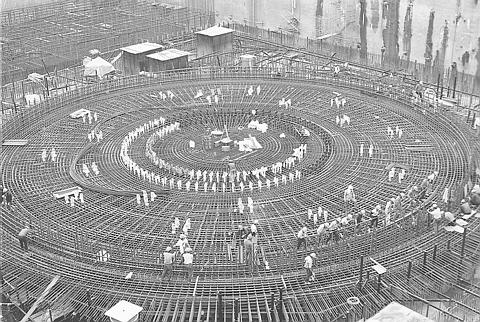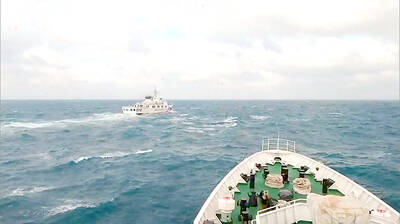Anti-nuclear environmentalists and legislators called for a delay of the construction the island's fourth nuclear power plant after locating several problems during a field investigation yesterday.
Taiwan Power Company (
Following the 921 earthquake last month, lawmakers and environmentalists have asked for a comprehensive review of the safety of Taiwan's three existing nuclear power plants.

PHOTO: CHEN CHENG-CHANG, TAIPEI TIMES
In addition, they have also urged the government to reconsider plans for a fourth nuclear power plant, which is located near five known fault lines.
DPP lawmakers Lin Chung-mo (
"The plant is designed to resist big earthquakes. But we don't think a devastating tremor like the 921 earthquake would happen here because the five faults nearby have been identified as inactive," said Lin Chu-wan (
According to Taipower, the construction of the plant, initiated last year, is currently 29 percent complete and will be finished by 2005. So far, the company has invested NT$36.4 billion in the project.
Although earthquake-sensing equipment has yet to be established at the site, Lin said that several instruments have been set up to monitor construction conditions, including pressure, tension, and displacement to ensure safety.
During the field investigation, the three lawmakers observed problems such as rusty reinforcing bars and seawater seeping into the foundation of the plant, which has long worried residents living nearby. Residents in the area have asked that construction of the plant be suspended.
"We don't think it's a good idea to continue construction until the confusion that local residents feel is dispelled," said DPP lawmaker Lin.
However, Taipower officials said that the things the lawmakers were concerned about were actually within guidelines.
"We engineers think the current situation (the existence of rust on reinforce bars) is allowable," Taipower's Lin said.
In addition, Lin that said groundwater around the site has been monitored carefully to see if any seawater has penetrated the construction site.
However, activists from the Taiwan Environmental Protection Union (
Taipower has been using nuclear power as one of its energy sources since 1964.
However, building nuclear power plants has become a tedious process as disputes between the government and environmentalists have become common-place.
It wasn't until 1978 that the first nuclear power plant started operating.
Since then, environmental activists have brought several controversial environmental protection issues to light, including the death of clustered coral near hot waste water discharge pipes from plants and other coastal ecology problems.

Auckland rang in 2026 with a downtown fireworks display launched from New Zealand’s tallest structure, Sky Tower, making it the first major city to greet the new year at a celebration dampened by rain, while crowds in Taipei braved the elements to watch Taipei 101’s display. South Pacific countries are the first to bid farewell to 2025. Clocks struck midnight in Auckland, with a population of 1.7 million, 18 hours before the famous ball was to drop in New York’s Times Square. The five-minute display involved 3,500 fireworks launched from the 240m Sky Tower. Smaller community events were canceled across New Zealand’s

The Ministry of Foreign Affairs (MOFA) yesterday said it is closely monitoring developments in Venezuela, and would continue to cooperate with democratic allies and work together for regional and global security, stability, and prosperity. The remarks came after the US on Saturday launched a series of airstrikes in Venezuela and kidnapped Venezuelan President Nicolas Maduro, who was later flown to New York along with his wife. The pair face US charges related to drug trafficking and alleged cooperation with gangs designated as terrorist organizations. Maduro has denied the allegations. The ministry said that it is closely monitoring the political and economic situation

‘SLICING METHOD’: In the event of a blockade, the China Coast Guard would intercept Taiwanese ships while its navy would seek to deter foreign intervention China’s military drills around Taiwan this week signaled potential strategies to cut the nation off from energy supplies and foreign military assistance, a US think tank report said. The Chinese People’s Liberation Army (PLA) conducted what it called “Justice Mission 2025” exercises from Monday to Tuesday in five maritime zones and airspace around Taiwan, calling them a warning to “Taiwanese independence” forces. In a report released on Wednesday, the Institute for the Study of War said the exercises effectively simulated blocking shipping routes to major port cities, including Kaohsiung, Keelung and Hualien. Taiwan would be highly vulnerable under such a blockade, because it

UNRELENTING: China attempted cyberattacks on Taiwan’s critical infrastructure 2.63 million times per day last year, up from 1.23 million in 2023, the NSB said China’s cyberarmy has long engaged in cyberattacks against Taiwan’s critical infrastructure, employing diverse and evolving tactics, the National Security Bureau (NSB) said yesterday, adding that cyberattacks on critical energy infrastructure last year increased 10-fold compared with the previous year. The NSB yesterday released a report titled Analysis on China’s Cyber Threats to Taiwan’s Critical Infrastructure in 2025, outlining the number of cyberattacks, major tactics and hacker groups. Taiwan’s national intelligence community identified a large number of cybersecurity incidents last year, the bureau said in a statement. China’s cyberarmy last year launched an average of 2.63 million intrusion attempts per day targeting Taiwan’s critical